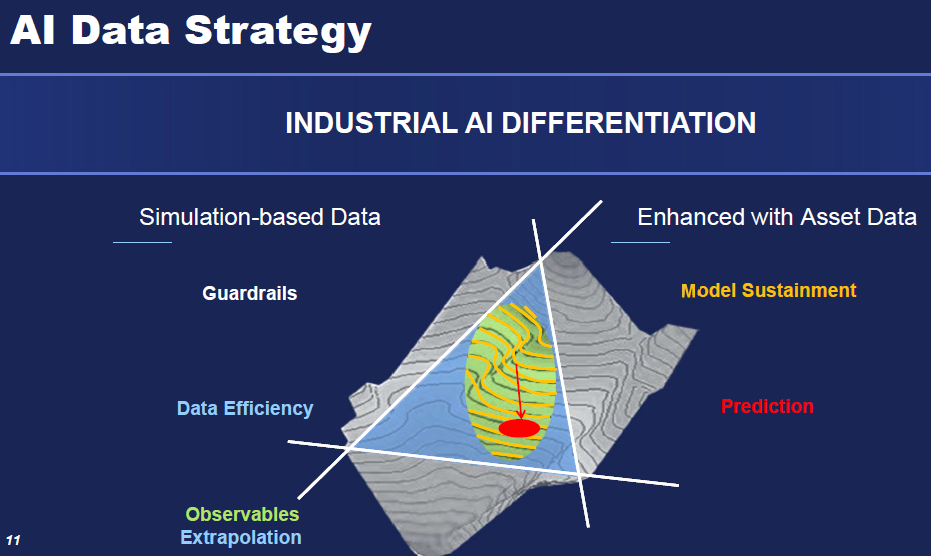Heiko Claussen, Chief Technologist with Emerson’s Aspen Technology business, presented “Industrial AI in Asset-Intensive Companies Brings Agility, Guidance & Automation” at the Emerson Exchange 2025 Conference. Here is his presentation abstract.
This presentation will describe AspenTech’s Industrial AI Strategy. Building on a 20-year journey of AI innovation; AspenTech’s AI strategy involves purpose built industrial AI that seamlessly integrates into AspenTech’s asset optimization software. This presentation will explain how Industrial AI delivers solutions that provide guardrails, deliver robust answers, and are trustworthy. The presentation will focus on examples and use cases of creating agility, guidance and automation. We are already delivering value-creating use cases today, and will select several of these to present, with the customer challenge, solution and value metrics.
Heiko opened by defining artificial intelligence for industrial businesses. Artificial Intelligence (AI) is defined as a technology that enables software to perform tasks that typically require human intelligence, including learning, problem-solving, and decision-making.
EY research revealed that 50% of leaders expect to allocate more than 25% of their total budget to AI investments in the coming year, with the goal of improving productivity, creating a competitive advantage, increasing product innovation, and enhancing cybersecurity.
Industrial AI offers domain expertise in engineering fundamentals, asset knowledge, industry-specific expertise, and optimization. Data insights are created with advanced analytics, machine learning, deep learning, and generative AI. Industrial AI should include guardrails, robustness, and earned trust.
AspenTech products have contained Industrial AI for more than two decades. Products include Aspen Inferential Qualities (IQ), Aspen OptiPlant Automated Pipe Routing, Aspen Basic Engineering, Aspen Mtell, DMC3, Aspen SeisEarth, AspenTech OSI Forecast, Aspen Hybrid Models, Aspen Maestro, Aspen Virtual Advisor (AVA), and Strategic Planning for Sustainability Pathways.
Megatrends today include VUCA (volatility, uncertainty, complexity, and ambiguity), nearshoring, and rapid demographic change. The need for Industrial AI to provide guidance, agility, and automation is essential in addressing these megatrends.
The AspenTech AI strategy includes agility, guidance, and automation. Agility avoids state models and enables solution value, and requires model sustainment and alliance. Guidance lowers the entry barrier and unlocks trapped value using AVA everywhere.
Automation through generative design and optioneering reduces complexity and streamlines service.
Industrial AI differs from more general AI in that it includes simulation-based data with guardrails for safe zones, data efficiency, and observables extrapolation. It is enhanced with asset data that includes model sustainment and prediction.

The Inmation Industrial Data Fabric provides data security and data ontology, spanning the edge and cloud.
Heiko shared some examples of how Industrial AI is being used. From an agility perspective, hybrid models were developed that combine AI with first principles engineering and domain expertise. These address challenges such as feedstock volatility and sustainability goals. It improves accuracy by leveraging models built on physics principles and real-world conditions.
Another example of agility is intelligent alarming, which simplifies alarm interpretation by considering network topology and the association of alarm characteristics with suitable suppression.
In the guidance realm, an example of Industrial AI driving customer value is in strategic planning for sustainability pathways. It leverages generative AI to build new pathway structures and helps solve the “blank page” problem by providing a first draft for editing and iteration. It delivers faster time to value with guidance to construct model pathways.
Another guidance example is AVA for PIMS. It provides guidance to help understand scenarios, enabling better planning outcomes and increasing planner productivity and consistency by raising awareness of options to further optimize complex plans.
In the automation realm, an example of driving customer value with Industrial AI is with OptiPlant AI Equipment Layout. It enables optioneering to trade off non-functional requirements, thereby accelerating the time to lay out equipment and piping. The automated placement of equipment allows efficient exploration of design options.
For oil and gas exploration, ProbNet enhances seismic interpretation consistency and accuracy while also accelerating productivity in handling complex structures across multiple horizons. IT automates seismic horizon interpretation with trusted results.
AspenTech customers have documented double-digit results in each of these domains. Industrial AI facilitates the innovation process through all stages—idea generation, research, prototyping, product development, and final product. You can find a complete AI curriculum on the AspenTech website.
